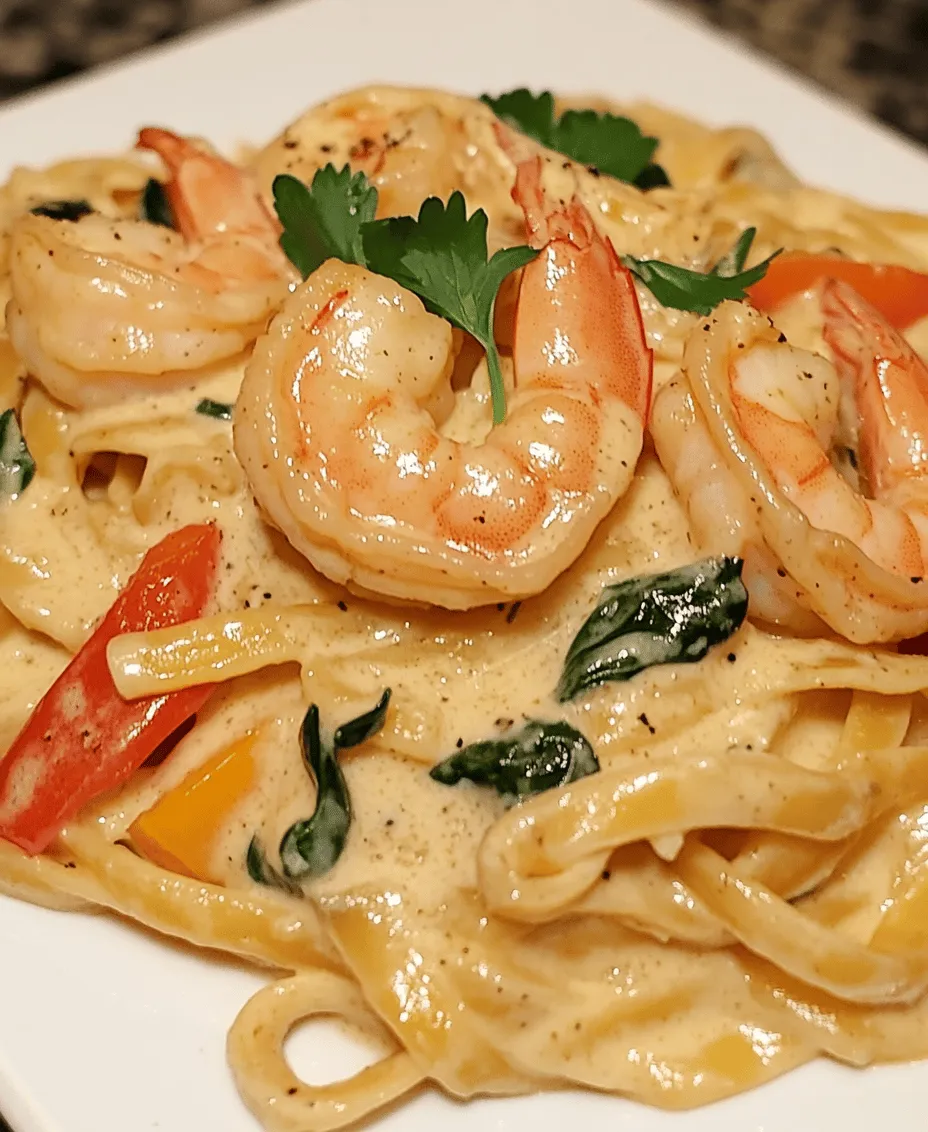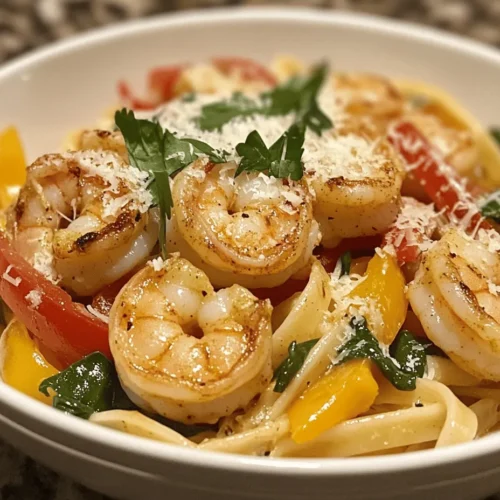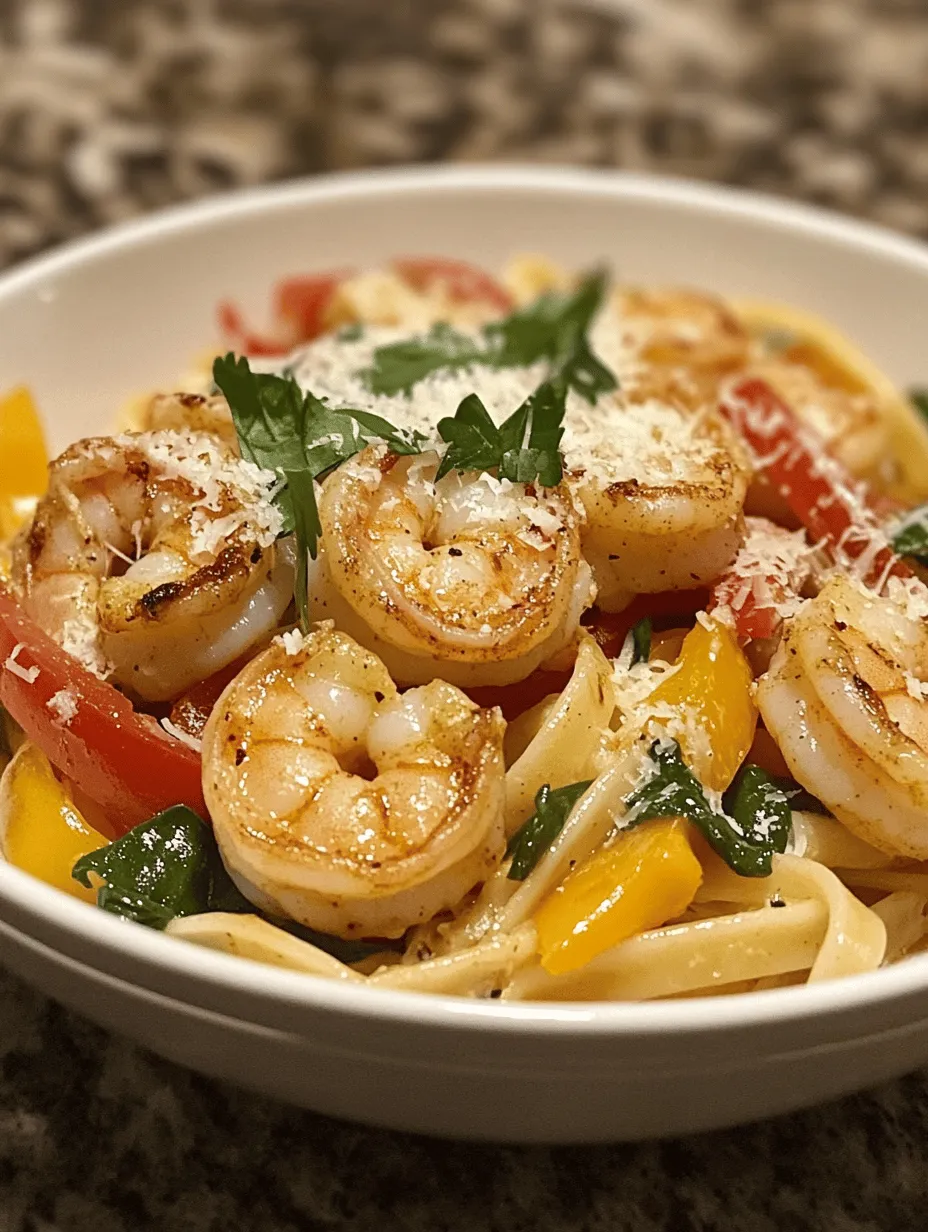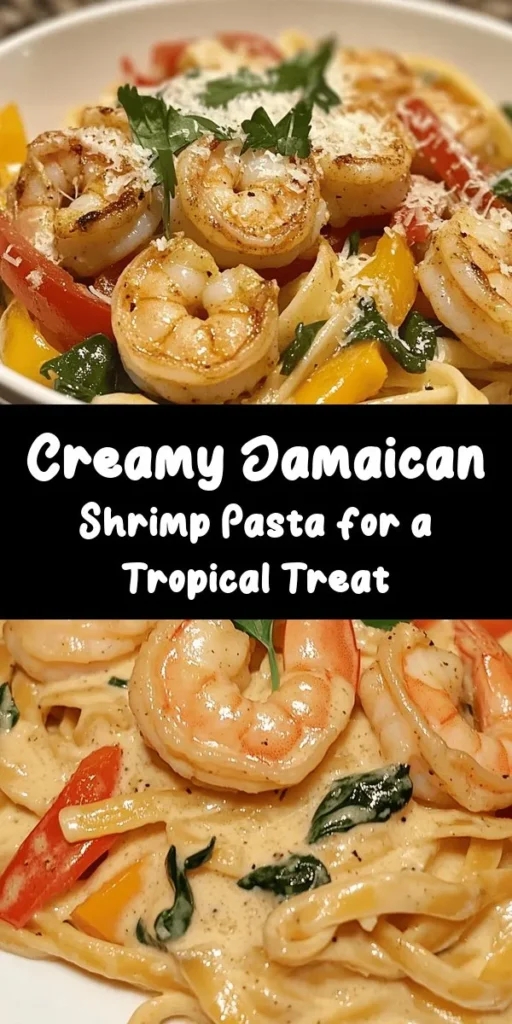Introduction
Jamaican Shrimp Pasta is a dish that captures the essence of Caribbean cuisine, bringing together vibrant flavors and fresh ingredients to create a delightful culinary experience. This dish combines the richness of a creamy sauce with the vibrant, spicy notes characteristic of Jamaican cooking, creating a meal that is both comforting and exciting. The use of succulent shrimp paired with perfectly cooked linguine pasta makes this dish suitable for various occasions, from casual weeknight dinners to elegant gatherings with friends and family.
What sets Jamaican Shrimp Pasta apart is its versatility. It’s not just another pasta dish; it’s an invitation to explore the rich culinary traditions of Jamaica, where seafood is celebrated and fresh produce reigns supreme. The creamy sauce, infused with the distinctive taste of jerk seasoning, elevates this dish to a level that impresses both the palate and the eye. This recipe is perfect for those who want to indulge in a hearty meal while enjoying the bright, tropical flavors of the Caribbean.
Understanding Jamaican Cuisine
To fully appreciate Jamaican Shrimp Pasta, it’s essential to understand the broader context of Jamaican cuisine. Jamaican culinary traditions are deeply rooted in a fusion of cultures, including African, European, Indian, and Chinese influences. This melting pot of flavors has given rise to a unique culinary identity characterized by vibrant spices, fresh ingredients, and bold flavors.
Jamaican food is known for its use of jerk seasoning, a spice blend comprising allspice, thyme, garlic, and scotch bonnet peppers, among other ingredients. This seasoning is not only a staple in Jamaican cooking but also a hallmark of its culinary heritage. The term “jerk” refers to a cooking technique that involves marinating meat (often chicken or pork) with this spice blend and then slow-cooking it over pimento wood. The resulting flavor is smoky, spicy, and utterly irresistible.
Seafood is also an integral part of Jamaican cuisine, thanks to the island’s abundant access to the ocean. Shrimp, in particular, is celebrated for its versatility and can be found in various traditional Jamaican dishes. The incorporation of pasta into this seafood dish reflects the growing trend of blending different culinary traditions, making Jamaican Shrimp Pasta a perfect example of cultural fusion in food.
Ingredients Breakdown
Creating a delicious Jamaican Shrimp Pasta begins with understanding the ingredients that contribute to its unique flavor profile. Each component plays a pivotal role in achieving the dish’s creamy texture and vibrant taste.
Linguine Pasta
Linguine is the pasta of choice for this recipe. Its flat, narrow shape makes it ideal for holding onto the creamy sauce, ensuring that each bite is packed with flavor. When cooking linguine, it’s essential to use plenty of water and to add a good amount of salt. This not only prevents the pasta from sticking but also enhances its natural flavor. Cooking linguine to al dente is crucial, as it should retain a slight bite, allowing it to absorb the sauce beautifully.
Shrimp
Freshness is key when it comes to shrimp. Sourcing high-quality, sustainable seafood ensures that your dish is not only delicious but also environmentally friendly. Look for shrimp that are firm to the touch and have a mild, ocean-like scent. If possible, opt for wild-caught shrimp to support sustainable fishing practices. When preparing shrimp for this dish, it’s essential to devein and peel them, allowing their natural sweetness to shine through in the creamy sauce.
Olive Oil
Olive oil is a staple in this recipe, adding flavor and richness to the dish. It is known for its health benefits, including heart-healthy fats and antioxidants. When choosing olive oil, opt for extra virgin olive oil for the best flavor. If you prefer, alternatives like avocado oil or coconut oil can be used, each adding its unique character to the dish.
Garlic and Onion
The combination of garlic and onion serves as the flavor base for the sauce, providing depth and aroma. Garlic, with its pungent, earthy flavor, enhances the overall taste of the dish, while onion adds sweetness and texture. Both ingredients come with health benefits, including anti-inflammatory properties and immune system support.
Bell Pepper
Bell peppers add not only a pop of color but also a crunch and subtle sweetness to the dish. They are rich in vitamins A and C, making them a nutritious addition. For this recipe, you can choose from various colors—red, yellow, or green—each offering a slightly different flavor profile. Incorporating a mix of bell peppers can create a visually appealing and flavorful dish.
Coconut Milk
Coconut milk is a key ingredient that brings creaminess to the sauce. Its rich, tropical flavor complements the shrimp and jerk seasoning beautifully, creating a harmonious balance. Coconut milk is also versatile in cooking, used in various dishes ranging from curries to desserts. Additionally, it offers health benefits, including healthy fats and vitamins.
Heavy Cream
To achieve the ultimate creaminess in your sauce, heavy cream is added. This ingredient thickens the sauce and enhances the richness of the dish. If you prefer a lighter version, you can substitute heavy cream with half-and-half or a plant-based cream alternative, but keep in mind that this may alter the flavor and texture of the dish.
Jamaican Jerk Seasoning
No Jamaican dish would be complete without jerk seasoning. This spice blend infuses the pasta with the distinctive flavors of Jamaica. While many store-bought options are available, making your own jerk seasoning allows you to control the spice levels and ingredient quality. Common ingredients include allspice, thyme, garlic powder, onion powder, and scotch bonnet peppers. A homemade jerk seasoning can elevate your dish, making it truly authentic.
Spinach
Adding spinach not only provides a vibrant green color but also boosts the nutritional profile of the dish. Spinach is rich in vitamins, minerals, and antioxidants, making it a powerhouse of health benefits. It wilts quickly when cooked, making it an easy addition to the pasta.
Lime Juice
Fresh lime juice is crucial for balancing the flavors in Jamaican Shrimp Pasta. The acidity cuts through the richness of the cream and coconut milk, brightening the dish. It also enhances the freshness of the shrimp and vegetables, making every bite refreshing.
Parmesan Cheese
Finally, a sprinkle of Parmesan cheese adds a savory note to the dish. While Parmesan is the traditional choice, you can experiment with other cheeses like Pecorino Romano or even a dairy-free alternative if desired. The cheese enhances the creaminess and umami flavors, tying all the ingredients together beautifully.
Fresh Herbs for Garnish
To finish off the dish, fresh herbs such as cilantro or parsley can be used as a garnish. Not only do they add a burst of color, but they also enhance the overall flavor profile. Herbs bring a fresh, aromatic quality that complements the richness of the creamy sauce and the spiciness of the jerk seasoning.
By carefully selecting and preparing each ingredient, you set the stage for a delicious and satisfying meal. The combination of fresh shrimp, creamy sauce, and vibrant vegetables makes Jamaican Shrimp Pasta a dish that is sure to please. In the next part of the article, we’ll dive into the step-by-step instructions for preparing this delightful recipe, ensuring that you create a dish that captures the heart of Caribbean cuisine.

Step-by-Step Cooking Instructions
1. Cooking the Linguine
Start by bringing a large pot of salted water to a rolling boil. The importance of salting the water cannot be overstated; it enhances the flavor of the pasta itself. Use about 1-2 tablespoons of salt for a large pot of water. Once boiling, add your linguine and cook according to package instructions until it reaches al dente, usually about 8-10 minutes. Remember, the pasta will continue cooking slightly when combined with the sauce, so it’s essential not to overcook it. Once ready, reserve a cup of the pasta water and drain the rest. Set the linguine aside.
2. Sautéing the Shrimp
Next, heat a large skillet over medium-high heat and add a drizzle of olive oil. This will create a non-stick surface for the shrimp. Once the oil is hot, add your cleaned shrimp in a single layer. Avoid overcrowding the pan, as this will lead to steaming rather than sautéing. Cook the shrimp for about 2-3 minutes on each side until they turn pink and opaque. Season with salt, pepper, and a pinch of cayenne pepper for an extra kick. Once cooked, remove the shrimp from the pan and set them aside, leaving the residual oil and juices in the skillet.
3. Preparing the Vegetables
In the same skillet, add chopped bell pepper, diced onion, and minced garlic. Sauté for about 5 minutes or until the vegetables are soft and fragrant. You can add a pinch of salt to help draw out moisture and flavor from the vegetables. For optimal flavor, start with the onion, then add the bell pepper, followed by the garlic to avoid burning it. If you’re using any additional vegetables like zucchini or spinach, add them towards the end of this step to maintain their texture.
4. Crafting the Creamy Sauce
Once the vegetables are softened, it’s time to create the creamy sauce. Lower the heat to medium and pour in your coconut milk, stirring gently to combine with the sautéed vegetables. For an extra layer of flavor, add a tablespoon of tomato paste and a teaspoon of jerk seasoning at this stage. Allow the sauce to simmer for about 5 minutes, letting it thicken slightly. If the sauce is too thick, use the reserved pasta water to achieve your desired consistency.
5. Combining Ingredients
Now, return the sautéed shrimp to the skillet, along with the cooked linguine. Toss everything together gently to ensure that the pasta and shrimp are evenly coated with the creamy sauce. If the mixture seems dry, add more reserved pasta water a little at a time until the desired creaminess is achieved. This is an essential step for ensuring that every strand of linguine is infused with flavor.
6. Final Touches
To elevate the dish, squeeze fresh lime juice over the pasta and sprinkle in some grated Parmesan cheese. The acidity from the lime juice will balance the richness of the sauce, while the cheese adds depth and creaminess. Toss everything once more to combine, and taste for seasoning, adjusting salt, pepper, or lime juice as needed.
Tips for Perfecting Jamaican Shrimp Pasta
– Avoiding Common Mistakes: One common pitfall is overcooking the shrimp, which leads to rubbery texture. Keep an eye on them as they cook; they should only take a few minutes. Also, be cautious with the salt; while it’s essential for flavor, too much can overwhelm the dish.
– Ingredient Substitutions: For those who prefer vegetarian options, you can substitute shrimp with firm tofu or chickpeas. Both options will absorb the flavors of the sauce beautifully. If you need a dairy-free version, simply omit the cheese or use nutritional yeast as a substitute.
– Adjusting Spice Levels: If you enjoy a milder flavor, reduce the amount of cayenne pepper in the shrimp seasoning or use a milder jerk seasoning. Conversely, if you like it spicy, add extra hot sauce or a pinch of crushed red pepper flakes to the sauce.
Serving Suggestions
– Ideal Pairings: Jamaican shrimp pasta pairs exceptionally well with a light side salad made of mixed greens, cucumbers, and a citrus vinaigrette. Alternatively, serve it alongside garlic bread or a crusty baguette to soak up any leftover sauce. For beverages, a chilled white wine or a refreshing coconut water can complement the dish wonderfully.
– Presentation Tips: To make your dish visually appealing, serve the pasta in a large bowl or individual plates, garnished with fresh cilantro or parsley and lime wedges. A sprinkle of extra cheese on top also adds an attractive finish.
– Cultural Context: Jamaican cuisine is known for its vibrant flavors and communal dining experiences. Serving this dish on special occasions, like family gatherings or celebrations, emphasizes the rich culinary heritage of Jamaica. It’s a dish that brings people together, celebrating both the flavors of the island and the joy of sharing a meal.
Nutritional Information
Per serving, Jamaican shrimp pasta typically contains:
– Calories: Approximately 550-600, depending on the exact ingredients used.
– Macronutrients:
– Protein: 25-30 grams from shrimp and cheese,
– Carbohydrates: 70-75 grams from linguine,
– Fats: 20-25 grams primarily from coconut milk and olive oil.
– Vitamins and Minerals: Rich in Vitamin C from the bell peppers and lime juice, and a good source of calcium from the cheese.
For those with dietary restrictions, gluten-free pasta can be used to make this dish suitable for gluten-sensitive individuals. Additionally, using almond or cashew milk in place of coconut milk can create a dairy-free and lower-calorie version.
Conclusion
Jamaican shrimp pasta is not only a delightful dish to prepare but also a feast for the senses, combining the freshness of seafood with the creaminess of coconut milk and the vibrant kick of spices. The balance of flavors, from the succulent shrimp to the rich sauce, makes it a standout addition to any meal plan.
This recipe showcases the beauty of Jamaican cuisine, offering a unique dining experience that can be enjoyed any day of the week or on special occasions. Don’t hesitate to explore different variations of this dish; whether you opt for different proteins, vegetables, or levels of spice, the possibilities are endless. Embrace the culinary magic of Jamaica and enjoy this creamy delight with family and friends.



